法観寺 八坂の塔(愛知県名古屋市千種区姫池通 骨董買取いたします 古美術風光舎名古屋店)
2022.05.31
皆さまこんにちは、スタッフNでございます。
温暖差でやられてしまったのでしょうか、PCの調子が悪くて困っております。
もう5月も終わりでございますね。
私はいまだに、月初めに行った京都のことを引きずって思い出しております。
今回は法観寺の五重塔について調べてみました。
法観寺(ほうかんじ)は、京都市東山区八坂上町にある臨済宗建仁寺派の寺院でございます。清水寺の近隣に位置しております。街中にそびえ立つ五重塔は通称「八坂の塔」と呼ばれ、周辺のランドマークとなっております。境内は狭く、塔以外に目だった建築物がないことから、「八坂の塔」は寺自体を指す通称ともなっているそうです。
伝承によれば五重塔は崇峻天皇5年(592年)に聖徳太子が如意輪観音の夢告により建てたとされ、その際仏舎利を三粒収めて法観寺と号しました。
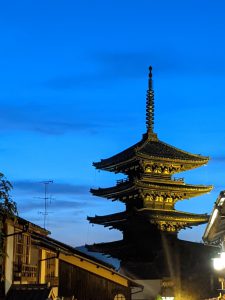
聖徳太子開基説は『山城州東山法観禅寺仏舎利塔記』(暦応元年(1338年))にみられます。聖徳太子創建の伝承は信憑性に疑いがあるものの、平安京遷都以前から存在した古い寺院であることは確かとされており、朝鮮半島系の渡来氏族・八坂氏の氏寺として創建されたという見方が有力だそうです。境内から出土する瓦の様式から、創建は7世紀にさかのぼるとみられます。現存する五重塔は15世紀の再建であるが、創建時の塔跡に建てられており、古代寺院に特有の地下式の心礎(心柱の礎石)が残っております。寺号は当初は八坂寺と称され、八坂寺の文献上の初見は『続日本後紀』承和4年(837年)条でだそうです。
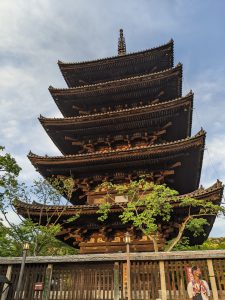
『延喜式』には、大膳職から盂蘭盆供養料を給される七寺の一として八坂寺の名がございます。五重塔は平安時代末期の治承3年(1179年)に清水寺と祇園社(八坂神社)との争いに巻き込まれて焼失しましたが、建久2年(1191年)に源頼朝の援助により再建されました。その後正応4年(1291年)に落雷で焼失し、延慶2年(1309年)に後宇多天皇の援助で再建されました。現在の塔は永享8年(1436年)の焼失後、同12年(1440年)に将軍足利義教の援助により再建されたものでございます。
その間、仁治元年(1240年)に建仁寺8世の済翁証救が入寺して中興し、臨済宗建仁寺派に属する禅寺となります。さらに暦応元年(1338年)より、夢窓疎石の勧めによって足利尊氏が全国に安国寺、利生塔を建てましたが、都の利生塔としてはこの塔を充て仏舎利を奉納いたしました。
戦国時代には、地方から上洛した大名が当寺に定紋入りの旗を掲げることによって、誰が新しい支配者・天下人になったかを世人に知らせたそうです。また、大島光義が豊臣秀次の命でこの塔の窓に矢を十本射込んで見せたとか。
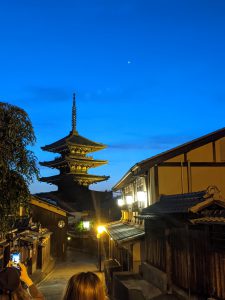
八坂の塔は内部に入ることができるうえに、塔の2層目まで一般人が普段から拝観で登ることができる日本唯一の重要文化財指定の五重塔でございます。ただし、公開は不定期(寺院関係者の都合の良い日のみ)であり、10:00 – 15:00という公開時間も、天候や寺院関係者の都合等により早く閉鎖されることもあります。シーズン中の週末に公開日は集中しますが、シーズン中の週末でも悪天候時は休むことが多く、好天の週末に休むこともあり「必ず内部を拝観できる日」は存在しないそうです。稀に平日に開いていることもあるため、確実に拝観したい場合は事前に電話等で確認が必要になります。
塔の内部に入ると仏像・壁画や礎石・心柱を見ることができます。急な階段を2層目まで登ると、窓ごしに町並みを展望できます。しかし、横を通る八坂通りから境内が見渡せることもあり、有料拝観者はそれほど多くないそうです。また、塔内の階段が急で危険なため、中学生未満の拝観はできません。悪天候時に拝観を休むのも、濡れた靴では階段でスリップする可能性が高まることも一因です。古い写真を見ると、最上層に金網が張っており、拝観者が最上層まで登れたことがわかります。
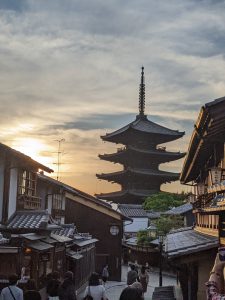
八坂の塔は、今回の観光でどこからでも眺めることが出来たので、登りませんでした。
今回こうやって調べてみると、登っておけばよかったかもと少し後悔しております。
夕暮れ時になると、カメラマンが続々と集まってきたので私も混ざって撮ってみました。
色々な角度からの五重塔、また違う味があって美しいですね。
昔の人の暮らしに触れるとどんどん古美術に興味が湧いて参ります。
ではでは
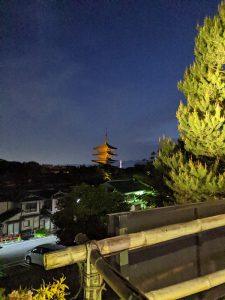
Hello everyone, this is Staff N.
I’m in trouble because my PC isn’t working well, maybe because of the temperature difference.
May is already over.
I still remember the Kyoto I went to at the beginning of the month.
This time, I investigated the five-storied pagoda of Hokanji Temple.
Hokanji is a temple of the Rinzai sect Kenninji school located in Yasaka Kamimachi, Higashiyama-ku, Kyoto. It is located near Kiyomizu Temple. The five-storied pagoda that rises in the city is commonly known as the “Yasaka Tower” and is a landmark in the surrounding area. Since the precincts are narrow and there are no outstanding buildings other than the tower, “Yasaka Tower” is also known as the temple itself.
According to folklore, the five-storied pagoda was built by Prince Shotoku in the 5th year of Emperor Sushun (592) according to the dream of Nyoirin Kannon.
The theory of the opening of Prince Shotoku can be found in “Higashiyama Hokan-ji Buddhist stupa in Yamashiro” (1338). Although the folklore of the founding of Prince Shotoku is doubtful, it is certain that it is an old temple that existed before the relocation of Heiankyo, and it is believed that it was built as a temple of the Korean Peninsula Toraijin, Yasaka. Seems to be influential. The style of the tiles excavated from the precincts suggests that the building dates back to the 7th century. The existing five-storied pagoda was rebuilt in the 15th century, but it was built on the site of the tower at the time of its construction, and the underground foundation stone (foundation stone of the pillar) peculiar to ancient temples remains. The temple name was originally called Yasakaji, and the first appearance in the literature of Yasakaji is said to be in the 4th year of Jōwa (837) in “Shoku Nihon Koki”.
In “Engi-shiki”, Yasaka-ji is one of the seven temples that receive offerings from the Daizen profession. The five-storied pagoda was burnt down in the 3rd year of the Jisho era (1179) at the end of the Heian period due to a conflict between Kiyomizu-dera and Gion Shrine (Yasaka Shrine), but was rebuilt in 1191 with the assistance of Minamoto no Yoritomo. it was done. After that, it was burnt down by a lightning strike in 1291, and was rebuilt in 1309 with the assistance of Emperor Go-Uda. The current tower was reconstructed in 1440 with the assistance of Shogun Ashikaga Yoshinori after it was burnt down in Eikyo 8 (1436).
Meanwhile, in the first year of Niji (1240), Kennin-ji VIII’s Kennin-ji Temple entered the temple and became a Zen temple belonging to the Rinzai sect Kennin-ji school. Furthermore, from the first year of the calendar (1338), Takauji Ashikaga built Ankoku-ji Temple and Risei Tower all over the country at the recommendation of Muso Soseki.
During the Warring States period, a daimyo from a rural area raised a flag with a fixed crest on the temple to let the world know who became the new ruler and heavenly man. Also, Mitsuyoshi Oshima shot ten arrows into the window of this tower at the behest of Hidetsugu Toyotomi.
The Yasaka Pagoda is the only five-storied pagoda designated as an important cultural property in Japan that can be entered inside and can be climbed up to the second floor of the pagoda by ordinary people. However, the exhibition is irregular (only on the days that are convenient for the temple staff), and the opening time of 10:00 –15:00 may be closed early due to the weather and the convenience of the temple staff. Open days are concentrated on weekends during the season, but even on weekends during the season, it is often absent in bad weather, and sometimes it is a holiday on a sunny weekend, so it seems that there is no “day when you can always see the inside”. In rare cases, it may be open on weekdays, so if you want to make sure to see it, you need to confirm by phone in advance.
When you enter the inside of the tower, you can see Buddha statues, mural paintings, cornerstones, and pillars. If you climb the steep stairs to the second floor, you can see the cityscape through the window. However, it seems that there are not so many paying visitors because the precincts can be seen from Yasaka-dori, which passes by. Also, because the stairs inside the tower are steep and dangerous, you cannot see them under junior high school students. Partly because of the rest of the day in bad weather and the increased likelihood of slipping on the stairs with wet shoes. If you look at the old photos, you can see that the wire mesh is on the top layer and the viewer can climb to the top layer.
I didn’t climb the Yasaka Tower because I could see it from anywhere during this sightseeing.
When I looked it up this time, I regret that I should have climbed it.
At dusk, cameramen gathered one after another, so I mixed in and took pictures.
The five-storied pagoda from various angles has a different taste and is beautiful.
When you come into contact with the lives of old people, you will become more and more interested in antique art.
See you soon
I’m in trouble because my PC isn’t working well, maybe because of the temperature difference.
May is already over.
I still remember the Kyoto I went to at the beginning of the month.
This time, I investigated the five-storied pagoda of Hokanji Temple.
Hokanji is a temple of the Rinzai sect Kenninji school located in Yasaka Kamimachi, Higashiyama-ku, Kyoto. It is located near Kiyomizu Temple. The five-storied pagoda that rises in the city is commonly known as the “Yasaka Tower” and is a landmark in the surrounding area. Since the precincts are narrow and there are no outstanding buildings other than the tower, “Yasaka Tower” is also known as the temple itself.
According to folklore, the five-storied pagoda was built by Prince Shotoku in the 5th year of Emperor Sushun (592) according to the dream of Nyoirin Kannon.
The theory of the opening of Prince Shotoku can be found in “Higashiyama Hokan-ji Buddhist stupa in Yamashiro” (1338). Although the folklore of the founding of Prince Shotoku is doubtful, it is certain that it is an old temple that existed before the relocation of Heiankyo, and it is believed that it was built as a temple of the Korean Peninsula Toraijin, Yasaka. Seems to be influential. The style of the tiles excavated from the precincts suggests that the building dates back to the 7th century. The existing five-storied pagoda was rebuilt in the 15th century, but it was built on the site of the tower at the time of its construction, and the underground foundation stone (foundation stone of the pillar) peculiar to ancient temples remains. The temple name was originally called Yasakaji, and the first appearance in the literature of Yasakaji is said to be in the 4th year of Jōwa (837) in “Shoku Nihon Koki”.
In “Engi-shiki”, Yasaka-ji is one of the seven temples that receive offerings from the Daizen profession. The five-storied pagoda was burnt down in the 3rd year of the Jisho era (1179) at the end of the Heian period due to a conflict between Kiyomizu-dera and Gion Shrine (Yasaka Shrine), but was rebuilt in 1191 with the assistance of Minamoto no Yoritomo. it was done. After that, it was burnt down by a lightning strike in 1291, and was rebuilt in 1309 with the assistance of Emperor Go-Uda. The current tower was reconstructed in 1440 with the assistance of Shogun Ashikaga Yoshinori after it was burnt down in Eikyo 8 (1436).
Meanwhile, in the first year of Niji (1240), Kennin-ji VIII’s Kennin-ji Temple entered the temple and became a Zen temple belonging to the Rinzai sect Kennin-ji school. Furthermore, from the first year of the calendar (1338), Takauji Ashikaga built Ankoku-ji Temple and Risei Tower all over the country at the recommendation of Muso Soseki.
During the Warring States period, a daimyo from a rural area raised a flag with a fixed crest on the temple to let the world know who became the new ruler and heavenly man. Also, Mitsuyoshi Oshima shot ten arrows into the window of this tower at the behest of Hidetsugu Toyotomi.
The Yasaka Pagoda is the only five-storied pagoda designated as an important cultural property in Japan that can be entered inside and can be climbed up to the second floor of the pagoda by ordinary people. However, the exhibition is irregular (only on the days that are convenient for the temple staff), and the opening time of 10:00 –15:00 may be closed early due to the weather and the convenience of the temple staff. Open days are concentrated on weekends during the season, but even on weekends during the season, it is often absent in bad weather, and sometimes it is a holiday on a sunny weekend, so it seems that there is no “day when you can always see the inside”. In rare cases, it may be open on weekdays, so if you want to make sure to see it, you need to confirm by phone in advance.
When you enter the inside of the tower, you can see Buddha statues, mural paintings, cornerstones, and pillars. If you climb the steep stairs to the second floor, you can see the cityscape through the window. However, it seems that there are not so many paying visitors because the precincts can be seen from Yasaka-dori, which passes by. Also, because the stairs inside the tower are steep and dangerous, you cannot see them under junior high school students. Partly because of the rest of the day in bad weather and the increased likelihood of slipping on the stairs with wet shoes. If you look at the old photos, you can see that the wire mesh is on the top layer and the viewer can climb to the top layer.
I didn’t climb the Yasaka Tower because I could see it from anywhere during this sightseeing.
When I looked it up this time, I regret that I should have climbed it.
At dusk, cameramen gathered one after another, so I mixed in and took pictures.
The five-storied pagoda from various angles has a different taste and is beautiful.
When you come into contact with the lives of old people, you will become more and more interested in antique art.
See you soon
*********************
風光舎では、古美術品や骨董品の他にも絵画や宝石、趣味のお品など様々なジャンルのものを買受しております。
お片付けをされていて、こういうものでもいいのかしらと迷われているものでも、どうぞお気軽にご相談下さいませ。
また風光舎は、出張買取も強化しております。
ご近所はもちろん、愛知県内、岐阜県、三重県その他の県へも出張いたします。
まずは、お電話お待ちしております。
愛知県名古屋市千種区・骨董 買取
『古美術 風光舎 名古屋店』
TEL 052(734)8444
10:00-17:00 OPEN

